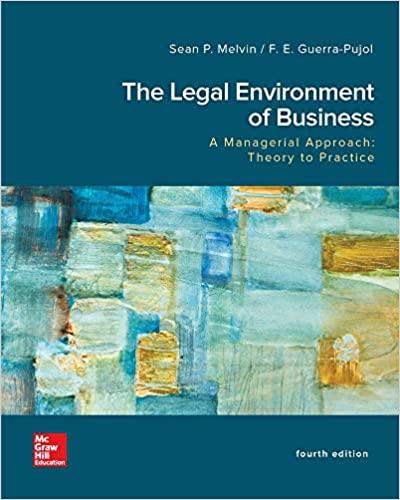Question
Assignment 4 DAA6D Trace the steps in a typical criminal trial from jury selection, through opening statements, to presentation of the trial evidence. Explain the
Assignment 4 DAA6D
Trace the steps in a typical criminal trial from jury selection, through opening statements, to presentation of the trial evidence. Explain the concepts of privilege and competency.
Discuss the hearsay rule.
Review a range of post-conviction issues, including: - appeal - habeas corpus - post-conviction employment
- expungement and pardons Explain the legal rights of those suffering from alcohol or drug addiction.
Review the provisions of the First Amendment as they relate to freedom of speech and the right to assembly.
Detail situations that are and are not protected by freedom of speech.
Discuss access to prisoners and courtrooms.
1. Your reading material uses the phrase "disparate impact" in the context of __________.
a. drug and alcohol addiction b. double jeopardy c. the use of habeas corpus d. race discrimination claims
2. Your reading material lists five reasons upon which a proposed juror may be subject to "challenge for cause." Which of the following is NOT specifically mentioned as one of these?
a. pre-trial publicity b. schedule conflict c. health and disability d. inability to follow the court's instructions
3. During an appeal the appellate court will review the record for __________.
a. errors in the law b. errors of fact c. bothaandb d. none of the above
4. Typically in a criminal case each side has __________ peremptory jury selection challenges, although the number increases in felony or death penalty cases.
a. two
b. three
c. five
d. ten
5. A state prisoner must use all means available within the state system to correct an alleged error before seeking the aid of the federal court. This is known as the doctrine of exhaustion of __________.
a. restitution b. due process c. litigation d. remedies
6. The two elements of relevance are __________.
a. materiality and probative value b. materiality and reasonable doubt c. reasonable doubt and probative value d. probative value and privilege
7. Which of the following is NOT protected to some degree by the Americans with Disabilities Act?
a. recovering drug addicts b. casual drug users c. alcoholics d. none of the above are protected by this act
8. Which of the following is a FALSE statement? a. A person's habit or routine practice is not admissible to prove that conduct on a particular occasion conformed with the habit or practice. b. As a general rule, character evidence may be used to prove a person's conduct. c. Evidence of other crimes a person may have committed is admissible to prove that he or she may have committed a crime in a particular situation. d. all of the above
9. The legal term "expungement" means to __________.
a. ban from publication b. release to the public c. wipe out information d. transfer to another jurisdiction
10. Your reading material mentions several specific instances of privilege that are recognized under the law. Which of the following is NOT specifically mentioned as one of these?
a. husband/wife privilege b. parent/child privilege c. clergyman's privilege d. newspaper reporter's privilege
11. The primary purpose of the First Amendment was to allow Americans to __________.
a. criticize their own government b. enjoy privacy in their own homes c. gain access to the court system d. be free from unreasonable searches and seizures
12. All persons over the age of __________ are presumed to be competent to testify. a. 10 b. 12 c. 14 d. 16
13. The Supreme Court divides speech into two categories: __________.
a. pure speech and adulterated speech b. pure speech and speech plus c. free speech and constrained speech d. ordinary speech and motivated speech
14. Your reading material offers three reasons for the hearsay rule. Which of the following is NOT specifically one of these?
a. A party's statements made out of court are never relevant to a court proceeding. b. A witness should be subject to contemporaneous cross examination. c. A witness should testify in the presence of the "trier" of fact. d. A witness should testify under oath or affirmation.
15. The court has ruled that conduct or speech is obscene if __________.
a. the average person applying contemporary community standards would find that the work as a whole appeals to the prurient interest b. the work depicts or describes in a patently offensive way sexual conduct specifically defined by the applicable state law c. the work taken as a whole lacks serious artistic, political, or scientific value d. all of the above
16. For purposes of the hearsay rule, an assertion may be any of the following EXCEPT __________.
a. behavioral b. implicit c. oral d. written
17. Which of the following is a correct statement? a. Defamation and libel are both forms of slander. b. Slander and defamation are both forms of libel. c. Slander and libel are both forms of defamation. d. none of the above
18. Appeals from a state court to the U.S. Supreme Court must be filed within __________ days of the entry of the judgment.
a. 10 b. 30 c. 60 d. 90
19. Typically, serious crimes are only pardoned if __________ or more years have passed since the crime was committed.
a. 10 b. 20 c. 30 d. 40
20. Under the collateral order doctrine, when may orders that are independent of a criminal case be appealed? a. immediately b. once the last action of the court is taken in the criminal case c. 10 days after the final order d. 30 days after the final order
Step by Step Solution
There are 3 Steps involved in it
Step: 1

Get Instant Access to Expert-Tailored Solutions
See step-by-step solutions with expert insights and AI powered tools for academic success
Step: 2

Step: 3

Ace Your Homework with AI
Get the answers you need in no time with our AI-driven, step-by-step assistance
Get Started


